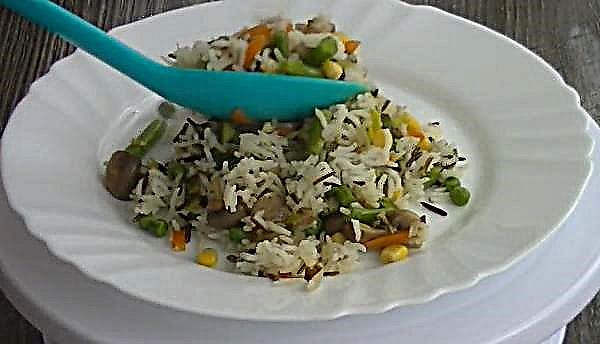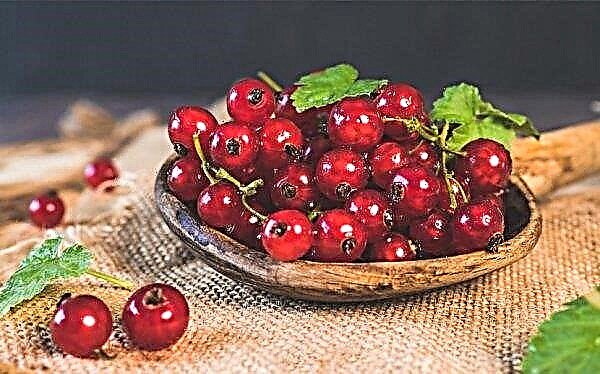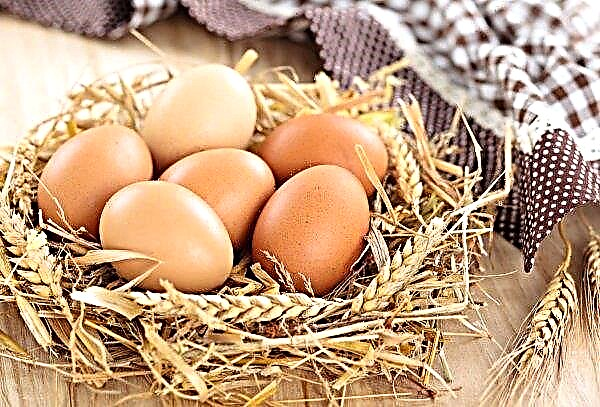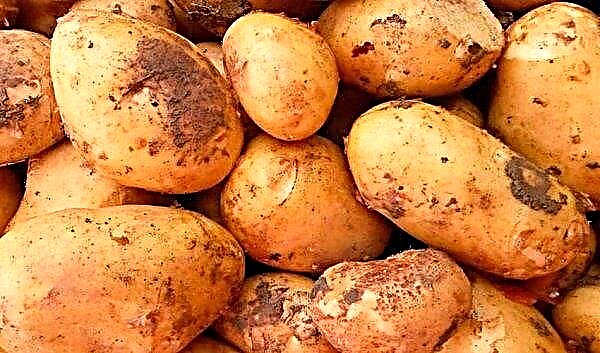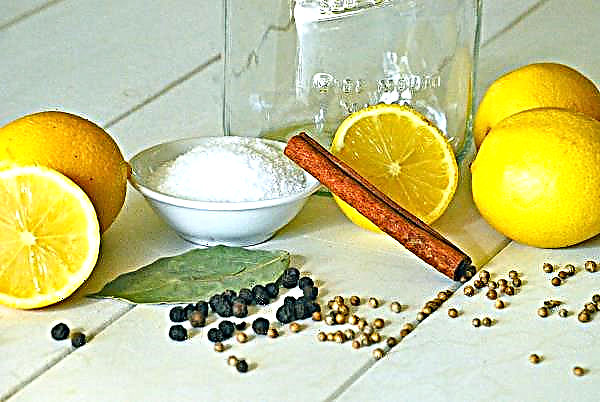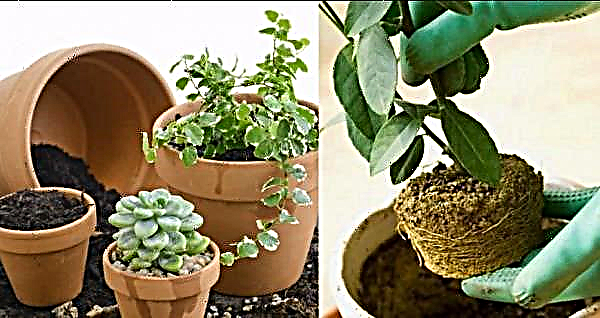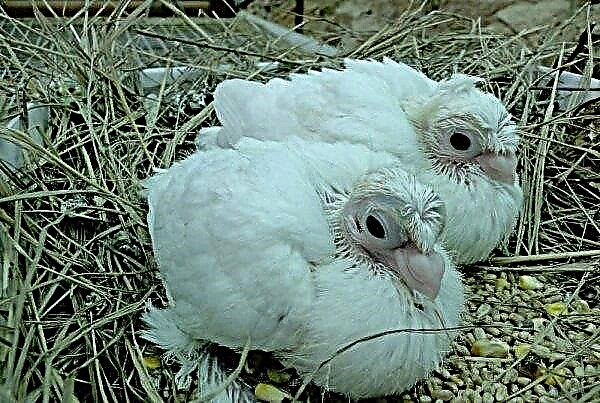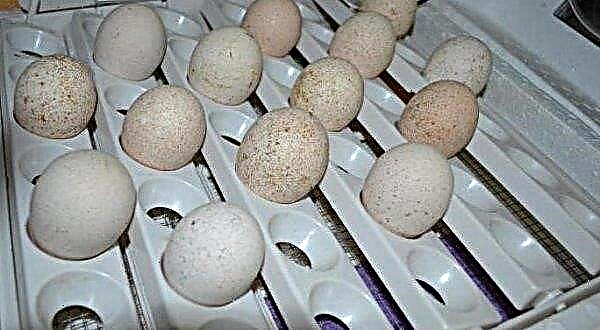The geranium kiss, a romantic symbol from Bob Dylan’s song, was borrowed by Oregon farmer Alan Kapuler for the name of the tomato variety he bred. The bush with these fruits is really very beautiful and resembles a geranium flower, especially when grown in pots. The variety appeared about 10 years ago and has already managed to gain popularity among gardeners around the world. From the article you will learn why it is so attractive.
Did you know? "The kiss of geraniums» very decorative variety. It can be grown in pots, flowerpots and even hanging flower pots.
Grade description
This original variety belongs to the type of cherry and has the following characteristics:
- early ripening period (can be collected already 90 days after planting);
- undersized determinant bush (average height is 60 cm, in greenhouses can reach 1 m);
- does not require pinching, on the contrary, it is recommended to leave 3-4 lateral shoots for greater productivity;
- can be grown both in open ground and in a greenhouse (in northern latitudes);
- lush bush with green leaves of potato type;
- high-yielding (from 60 to 100 berries are tied in one brush, the average yield is about 6 kg per bush);
- long growing season (up to frost);
- fruit weight is 20–40 g;
- fruits are red-raspberry, round-plum-shaped with a small sharp nose at the end;
- the peel is dense, does not crack;
- the pulp is juicy, there are few seeds in it;
- the taste is tomato, sweet;
- universal variety (used for salads, soups, preservation, sauces, juices);
- resistant to disease;
- It is recommended to plant at the rate of 4-5 bushes per 1 m².

Advantages and disadvantages
- The variety has many advantages:
- excellent yield;
- compactness;
- the ability to grow in any conditions (in the garden / apartment / garden / greenhouse);
- beautiful appearance of bushes and fruits;
- good taste;
- universality of culinary processing;
- unpretentiousness in leaving;
- immunity to diseases.
- Among the few shortcomings of this plant can be noted:
- susceptibility to fungal infections;
- sensitivity to low temperatures.
Did you know? The state of Oregon is famous for experimenters in the field of selection. In addition to the variety in question, in 2003 a hybrid was bred there. entitled «Tomakko» (tomato crossed with tobacco).
Self-growing seedlings
In regions with a mild climate, the considered tomatoes can be sown in the first half of March directly into the ground, bypassing the seedling stage. In the middle lane and in the north, you must first sow the seeds in the tank and keep them indoors.
Optimum timing for sowing
Sowing seedlings is best done in early February.
The soil
This variety has the following soil requirements:
- friability;
- ease;
- water tightness;
- neutral or weak acidity (pH up to 5.5–6);
- previous crops should not be nightshade;
- ideal precursors on the ground - carrots, zucchini, pumpkin, beets, cabbage, cucumbers.
Important! For «Geranium kiss» peat is good (in combination with river sand, humus and leafy land), but it is necessarily lowland. Horse peat will be too acidic.
The soil before sowing must be decontaminated by the following methods:
- 2-3 times freezing (in the freezer or outdoors at a temperature of –15 ° C);
- heat treatment (in the oven or in a double boiler);
- disinfection by special means (potassium permanganate, fungicides, insecticides).
After processing, the earth is poured onto a paper surface and allowed to fill with air. So she will become more loose.
Capacity for growing
Any capacity will do:
- wooden boxes;
- glass jars;
- glasses;
- boxes.
 Previously, the seeds can be planted in peat tablets, and from there they can already be transplanted into the selected container. Sometimes you can see growing seeds on wet cotton pads or in “snails” made of paper, but for beginner gardeners the classic way is suitable.
Previously, the seeds can be planted in peat tablets, and from there they can already be transplanted into the selected container. Sometimes you can see growing seeds on wet cotton pads or in “snails” made of paper, but for beginner gardeners the classic way is suitable.Seed preparation
Industrial seeds purchased in packaging do not need to be processed, otherwise you can damage the layer of nutrients already applied to them. Self-collected or taken from friends require disinfection with 1% potassium permanganate solution for 30 minutes.
Important! If the seeds are very dry, they cannot be immediately immersed in the solution. It is necessary to pre-soak in warm boiled water for several hours.
After the disinfecting procedures are completed, the seeds are treated with one of the biostimulants:
- "Epin Extra";
- "Buzzard";
- Gumifild;
- "Titanite";
- Maxicrop Extra.
Sowing seeds
The seed planting algorithm includes the following actions:
- Moisten the soil in the sowing tank.
- Make small grooves or holes in the soil with a depth of not more than 1 cm.
- The scheme for planting in a box is 2 × 2 cm, in cups / jars - 2 × 3 cm.
- In the prepared grooves, put seeds (3-4 pieces each) and sprinkle with earth.
- Future seedlings are covered with polyethylene and placed in a warm place.

Seedling Care
In addition to the fact that the room where the seedlings are located should be warm (the first days +25 ... + 26 ° С, then at least +20 ... + 22 ° С), the following conditions must also be observed:
- lighting for 16 hours a day (preferably placed on the windowsill from the sunny side);
- watering with warm water as needed;
- when the first four leaves appear dive in baboutsmall pots (for more comfortable development of the root system);
- top dressing (weak mineral fertilizer) is introduced with watering only 2 times before planting.
Seedling hardening
In order to reduce plant stress during transplantation into open ground, it is necessary to conduct hardening. To do this, the seedlings are taken out to fresh air, starting from half an hour a day and gradually increasing the time to 8–9 hours.
When hardening, seedlings should not be affected:
- rain,
- strong wind,
- cold (air temperature not lower than +8 ° С),
- direct sunlight (to avoid burns).
Planting seedlings in a permanent place
Resettlement of seedlings to beds is usually done in the second half of May, when the threat of frost passed and the earth warmed up to 15 °. The protective film, however, must be kept at hand in the event of a cold snap.
By the time of placement in open ground, the first flowers already appear on seedlings, so it is better not to delay the planting process too much for the plant to develop and bear fruit properly. The growing area should be sunny and protected from strong winds.
It is better to start planting seedlings in the afternoon. Transplantation includes the following stages:
Transplantation includes the following stages:
- Stopping watering in three days.
- Wells are made in the selected area at the rate of 4–5 bushes per 1 m² with a distance between rows of 40–45 cm and a width between bushes of 30–35 cm.
- The depth of the holes is about 10 cm.
- The bottom of the holes is well erupted for faster rooting of the growth of the bush.
- It is recommended to mulch the soil to prevent weeds and preserve moisture by digging in straw, sawdust, compost.
- Fertilizer is introduced into the hole, then warm water is poured with a drop of potassium permanganate.
- Saplings are deepened and covered with earth, once again irrigating with water and leaving until the next watering.
Outdoor Care
Consider the conditions under which this tomato variety will develop well and yield a crop.
Watering
Watering is carried out in the morning or in the evening by drip irrigation. The frequency of watering depends on the condition of the soil. For the “Kiss of geraniums”, both wetness and insufficient moisture are equally harmful. When watering, water should not be allowed to fall on the leaves.
Top dressing
The roots of these tomatoes spread underground throughout the garden, so fertilizers need to be applied to the entire surface, and not just under the bush. Top dressing is done every 10 days along with watering. It is best to use mineral complexes that already contain the necessary nutrients.
Such drugs have proven themselves well:
- "Plantafol";
- "Nanovit";
- "Biopon".
Stepson
Due to the undersized shrub, pinching is not required. The formation of 4 stems is recommended for greater productivity. Experienced gardeners advise removing the lower leaves when forming a brush, this will improve ventilation and prevent the appearance of pests and diseases. When grown in a greenhouse, the bush can grow up to a meter, in which case the shoots are nipped and the bush is formed into 2 stems.
When grown in a greenhouse, the bush can grow up to a meter, in which case the shoots are nipped and the bush is formed into 2 stems.
Soil care
The beds are regularly weeded, getting rid of weeds. Once every 2 weeks, a loosening procedure is carried out to provide the roots with free access to moisture and air. For loosening and weeding, it is convenient to use a tool such as the Fokin plane cutter. To save time for weeding and loosening, the soil on the beds is mulched, creating a layer 5–7 cm thick (from hay, straw, sawdust, compost), which will protect the soil from overheating and keep moisture. Properly performed mulching eliminates the need for too frequent weeding.
Bush tying
The garter of the bush is used to prevent semi-determinant and indeterminate plants from spreading on the ground. Despite the fact that the bush of the tomato in question is compact and stunted, it still needs to be tied so that it does not break under the weight of the hands.
For this, the main trunk is first tied up, and then, as it grows, the side stems.
For garter use one of two methods:
- Supporting. The bushes are tied with ribbons to vertical wooden supports (pegs) about a meter high (for greenhouse tomatoes - 1.5 m).
- Tapestry. At the opposite ends of the beds, stable columns are placed, between which a horizontal trellis is attached, to which the bushes are tied, first at the top, and in the process of maturation and brush.


Harvesting
With proper care and good weather conditions, the variety will delight you with a plentiful harvest in early July. You can still pick tomatoes in a half-ripened form, they will perfectly finish in boxes. In addition, in this form they are best transported.
Ripe tomatoes of this variety do not tolerate long-distance transportation. Harvested once a week, in September, removing all remaining berries. The variety does not tolerate low temperatures and can get sick.
The “Geranium Kiss” impresses everyone who grows it with its yield indicators, beautiful appearance, and undemanding care. Cherry lovers and children especially like it. Thanks to the small, neat fruit, the variety is very good for canning.
To get a large number of juicy, tasty tomatoes, you just need to follow the simple rules of care discussed in the article.

